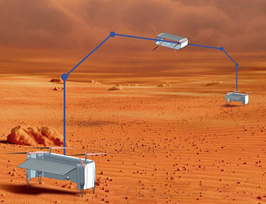LEMFEV
LONG ENDURANCE MARS EXPLORATION FLYING VEHICLE

LEMFEV Design and Analysis
Here, we share the features of our Martian airplane
LEMFEV Geometry and Configuration
The current version of the aircraft layout is a tailsitter boxplane, with no fuselage and empennage, no control surfaces, and a solar-based electric distributed propulsion system providing thrust, control, and balance. The aircraft’s mass is 6.3 kg, including a 0.8 kg payload and a 1.5 kg battery; its cruise speed is 49 m/s, corresponding to a Reynolds number of 8e+04 and a Mach number of 0.37; its cruise lift-to-drag ratio reaches 4.



LEMFEV Mission and Flight Profiles
Out of possible scientific targets for a Martian probe, we consider the craters and canyons, as well as the Martian planetary boundary layer.
The analysed flight missions of this Martian aircraft included the following tasks:
1) to perform profile measurements on the required timescales;
2) to carry instruments to the prescribed sites and conduct on-surface measurements.
When flying to the maximum range at an altitude of 15 m, the estimated range of the BW1 is 93 km at a speed of 54 m/s. When performing mapping at an altitude of 50 m, the UAV can cover a surface area of 0.98 km2 with a 30% overlap of adjacent scanning strips. Due to the significantly limited time in vertical modes, the difference in atmospheric density during ascent in the atmosphere and descent into the crater has virtually no effect on the expected flight and technical characteristics of the UAV: at a vertical speed of 1 m/s, the maximum ascent height and minimum descent depth into the crater are about 190 m.



